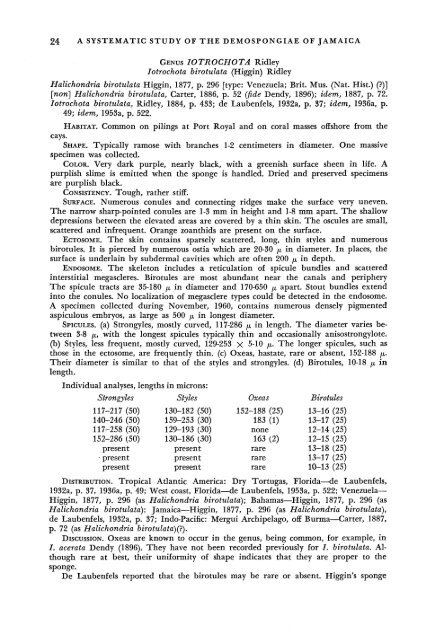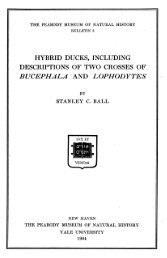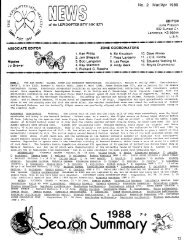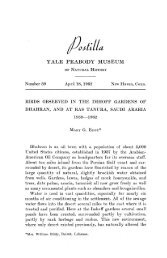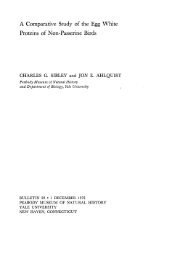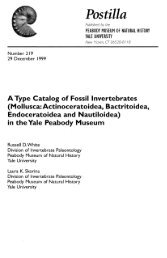Bulletin 20 - Peabody Museum of Natural History - Yale University
Bulletin 20 - Peabody Museum of Natural History - Yale University
Bulletin 20 - Peabody Museum of Natural History - Yale University
You also want an ePaper? Increase the reach of your titles
YUMPU automatically turns print PDFs into web optimized ePapers that Google loves.
24 A SYSTEMATIC STUDY OF THE DEMOSPONGIAE OF JAMAICA<br />
GENUS IOTROCHOTA Ridley<br />
Iotrochota birotulata (Higgin) Ridley<br />
Halichondria birotulata Higgin, 1877, p. 296 [type: Venezuela; Brit. Mus. (Nat. Hist.) (?)]<br />
[non] Halichondria birotulata, Carter, 1886, p. 52 (fide Dendy, 1896); idem, 1887, p. 72.<br />
Iotrochota birotulata, Ridley, 1884, p. 433; de Laubenfels, 1932a, p. 37; idem, 1936a, p.<br />
49; idem, 1953a, p. 522.<br />
HABITAT. Common on pilings at Port Royal and on coral masses <strong>of</strong>fshore from the<br />
cays.<br />
SHAPE. Typically ramose with branches 1-2 centimeters in diameter. One massive<br />
specimen was collected.<br />
COLOR. Very dark purple, nearly black, with a greenish surface sheen in life. A<br />
purplish slime is emitted when the sponge is handled. Dried and preserved specimens<br />
are purplish black.<br />
CONSISTENCY. Tough, rather stiff.<br />
SURFACE. Numerous conules and connecting ridges make the surface very uneven.<br />
The narrow sharp-pointed conules are 1-3 mm in height and 1-8 mm apart. The shallow<br />
depressions between the elevated areas are covered by a thin skin. The oscules are small,<br />
scattered and infrequent. Orange zoanthids are present on the surface.<br />
ECTOSOME. The skin contains sparsely scattered, long, thin styles and numerous<br />
birotules. It is pierced by numerous ostia which are <strong>20</strong>-30 fi in diameter. In places, the<br />
surface is underlain by subdermal cavities which are <strong>of</strong>ten <strong>20</strong>0 /x in depth.<br />
ENDOSOME. The skeleton includes a reticulation <strong>of</strong> spicule bundles and scattered<br />
interstitial megascleres. Birotules are most abundant near the canals and periphery<br />
The spicule tracts are 35-180 p in diameter and 170-650 ^ apart. Stout bundles extend<br />
into the conules. No localization <strong>of</strong> megasclere types could be detected in the endosome.<br />
A specimen collected during November, 1960, contains numerous densely pigmented<br />
aspiculous embryos, as large as 500 /x in longest diameter.<br />
SPICULES, (a) Strongyles, mostly curved, 117-286 p, in length. The diameter varies between<br />
3-8 /x, with the longest spicules typically thin and occasionally anisostrongylote.<br />
(b) Styles, less frequent, mostly curved, 129-253 x 5-10 /*. The longer spicules, such as<br />
those in the ectosome, are frequently thin, (c) Oxeas, hastate, rare or absent, 152-188 p.<br />
Their diameter is similar to that <strong>of</strong> the styles and strongyles. (d) Birotules, 10-18 /JL in<br />
length.<br />
Individual analyses, lengths in microns:<br />
Strongyles<br />
Styles<br />
Oxeas Birotules<br />
117-217 (50)<br />
140-246 (50)<br />
117-258 (50)<br />
152-286 (50)<br />
present<br />
- present<br />
present<br />
130-182 (50)<br />
159-253 (30)<br />
129-193 (30)<br />
130-186 (30)<br />
present<br />
present<br />
present<br />
152-188 (25)<br />
183 (1)<br />
none<br />
163 (2)<br />
rare<br />
rare<br />
rare<br />
13-16 (25)<br />
13-17 (25)<br />
12-14 (25)<br />
12-15 (25)<br />
13-18 (25)<br />
13-17 (25)<br />
10-13 (25)<br />
DISTRIBUTION. Tropical Atlantic America: Dry Tortugas, Florida—de Laubenfels,<br />
1932a, p. 37, 1936a, p. 49; West coast, Florida—de Laubenfels, 1953a, p. 522; Venezuela—<br />
Higgin, 1877, p. 296 (as Halichondria birotulata); Bahamas—Higgin, 1877, p. 296 (as<br />
Halichondria birotulata); Jamaica—Higgin, 1877, p. 296 (as Halichondria birotulata),<br />
de Laubenfels, 1932a, p. 37; Indo-Pacific: Mergui Archipelago, <strong>of</strong>f Burma—Carter, 1887,<br />
p. 72 (as Halichondria birotulata)(?).<br />
DISCUSSION. Oxeas are known to occur in the genus, being common, for example, in<br />
I. acerata Dendy (1896). They have not been recorded previously for 7. birotulata. Although<br />
rare at best, their uniformity <strong>of</strong> shape indicates that they are proper to the<br />
sponge.<br />
De Laubenfels reported that the birotules may be rare or absent. Higgin's sponge


